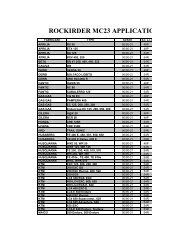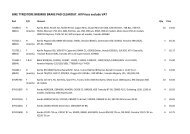You also want an ePaper? Increase the reach of your titles
YUMPU automatically turns print PDFs into web optimized ePapers that Google loves.
T E C H N I C A L R E C O M M E N D AT I O N SA N D I N F O R M AT I O NTyres are the only points of contact between a motorcycle or scooter and the road.The total contact area between a motorcycle's two tyres and the road is approximately 100 sq.centimetres, equivalent to the surface area of two credit cards. It is consequently essential to maintain thecondition and performance of your tyres.RADIAL CONSTRUCTIONTreadBreaker StripRadial casing plyBead wireCROSSPLY CONSTRUCTIONTreadBreaker StripCrossply casing plyBead wireOnly when participating in a legitimate, sanctionedcompetition event should rider preferences supersedemanufacturers’ pressure recommendationsPressures should be adjusted depending on type of terrain, weatherconditions, the motorcycle’s power output, and the style of riding.ASPHALT CIRCUITMINIMUM PRESSURES:DESERTMINIMUM PRESSURES:CROSS ET ENDURORECOMMENDED PRESSURES:MINIMUM PRESSURES:Front: 31 psiRear: 22 psiFront: 18 psiRear: 22 psiFront: 15 psiRear: 15 psiFront: 12 psiRear: 12 psiREPAIRSIn the event of a puncture, internal and external inspections must becarried out by a tyre specialist to determine whether the tyre isrepairable. Further advice on minor and major repairs can be foundin British Standard BS AU159f which covers repairs to most road goingvehicle types. Injection of air-tight products (tyre repair spray..) throughthe valve can only provide short-term solutions and are notconsidered to be an adequate repair.VERY IMPORTANT:After removing a tyre and before repairing it, you must thoroughlycheck its interior. Traces of marbling in the sidewall/tread area showthat the tyre has been run under inflated and therefore the damagecould show up again during running. In such a case, thetyre cannot be repaired.Tyres showing any of the following damage should not be used again:• Deformed or visible bead wire• Loose rubber or casing plies• Folded rubber or casing plies• Deterioration through chemicals, hydrocarbons or corrosivematerials• Internal rubber marbling caused by running under inflatedSidewallBead areaInterior rubber liningTYRE SELECTIONTyres must match the original specification of the bike manufacturer.The bike or tyre manufacturer must be consulted for advice if tyres ofalternative specifications are requested.INSPECTIONTyres must be inspected on a regular basis for irregular wear patterns,which can be an indication of incorrect inflation pressure, overloadingor mechanical problems. An under-inflated or overloaded tyre that isridden for a prolonged period may suffer irreversible damage that canhave serious consequences, even if the tyre is subsequently returnedto correct inflation pressure.Particular attention should be paid to:• The tread area, to detect the presence of debris, cuts, deteriorationor irregular wear patterns;• Sidewalls, to detect impact damage (from potholes or kerbs), cuts,cracking or abnormal deformation;• The bead area, noting any trace of rubbing or rim damage.• If you suspect any problems, you should inspect the tyre internallyand externally.WEARThe primary function of the tread is to develop adhesion with the road.As tyre wear progresses over time, the tyre’s capacity to clear waterdecreases; consequently, you should advise your customers to adapttheir riding speeds in wet conditions.Remember to check regularly for tyre wear, by checking wearindicator and uniformity of the wear pattern.Factors affecting wear: a tyre’s durability is dependent on seven mainfactors. Some are within the rider’s control, such as inflationpressure, loads carried, vehicle speed and riding style (braking andSidewallBead areaInterior rubber liningacceleration). Others are beyond the rider’s control and requireadaptation of one’s riding style: road profile, type of surface, ambienttemperature.Remember that the condition and maintenance of the bike can alsoinfluence premature wear, including warped rims, worn suspensioncomponents, loose steering-head bearings and/or frame misalignment.Any one of these factors can have a detrimental effect on tread life;a combination of several factors may cause significant wear.INFLATIONCorrect inflation pressure is essential to the rider’s safety, forcomfort and for the tyre’s durability. Adhering to the manufacturers’recommended pressures plays a major part in the vehicle’s handling.Inflation pressure has a major influence on the motorcycle’s handling,both in a straight line and when cornering, even at low speeds andwhen braking.Riding on under inflated tyres can cause premature wear, irreversibledamage to the tyre and, possibly, sudden loss of air which can havecatastrophic consequences.Tyres even in good condition, lose air gradually. It is essential to checkpressures when tyres are cold at least every two weeks. If thepressure is checked during or after a ride, the tyres will be hot, whichwill increase the indicated pressure. Never bleed air from a hot tyre.If the pressure reading is lower than the recommended pressure,air must be added to the tyre. Keep in mind that the indicatedpressure of a hot tyre can be as much as 0.3 bar higher than therecommended cold pressure.After checking pressures, don’t forget to reinstall a valve cap, with arubber seal which provides a primary seal for the valve mechanism.TRIALRECOMMENDED PRESSURES:MINIMUM PRESSURES:Front: 6 psiRear: 5 psiFront: 5 psiRear: 4 psiFITTING, BALANCING, REMOVALThe fitting and demounting of tyres, as well as balancing, should beundertaken only by a professional technician; improper handling ofthe tyre can damage it and put the riders and other road users safetyat risk.When replacing a tyre, you must ensure the following:• that the replacement tyre is of the same dimension and type theoriginal;• that the speed rating and load index of the replacement tyre areappropriate;• for certain motorcycles, the manufacturer specifies a particular brandand model of tyre. If in any doubt, always refer to the owner’s manualor the tyre manufacturer’s fitment guide for confirmation.The valve and valve cap should be replaced whenever a tyre ischanged, as these are essential to ensuring that the tyre is airtight.To ride on a public highway with slick or re-cut tyres or any tyres thatare marked NHS (Not for Highway Service) or “FOR COMPETITIONUSE” would contravene UK Legislation.In line with the European Directive 2001/95/CE, tyre distributors andusers should pay particular attention when dealing with tyres that arenot homologated for road use. Display of such tyres in sales outletsmust clearly show that these tyres are not homologated for road use.Moreover, the dealer must inform the customer of any elementsnecessary to their use* and of the risks involved if used in anunauthorised manner.* e.g. an appropriate licenceRUNNING-INWhen the tyre is new:• Remove labels before fitting the tyre to the motorcycle or scooter.• During the first 100 kilometres, the bike should be riddenat moderate speed, and cornering angles should be increasedprogressively, until the tyre reaches its optimal performance.WARM-UPYou should advise your clients that during the first few miles of eachride, they should travel at moderate speed until the tyres achieveoperating temperature and optimal grip.MIXING TYRESAll recommendations and precautions are based on equippingthe motorcycle or scooter with MICHELIN tyres both front and rear.Unless specifically recommended by MICHELIN, crossply and radialtyres should not be combined on a motorcycle or scooter.HANDLING AND STORAGETyres must be stored in dry, ventilated and temperature-controlledconditions, protected from direct sunlight and inclement weather.• Away from all chemicals, solvents or hydrocarbons, which canadversely affect the rubber mixture.• Away from sharp objects that can puncture the tyre, including metal,wood.• Away from heat sources or electrical devices.Non-respect of these recommendations could affect the performanceof a bike, could cause handling problems and/or could cause the tyreto damage which could endanger the safety of the user as well asthat of other parties.Michelin cannot be held liable for any damages that arise throughany use not in accordance with his instructions.3536




